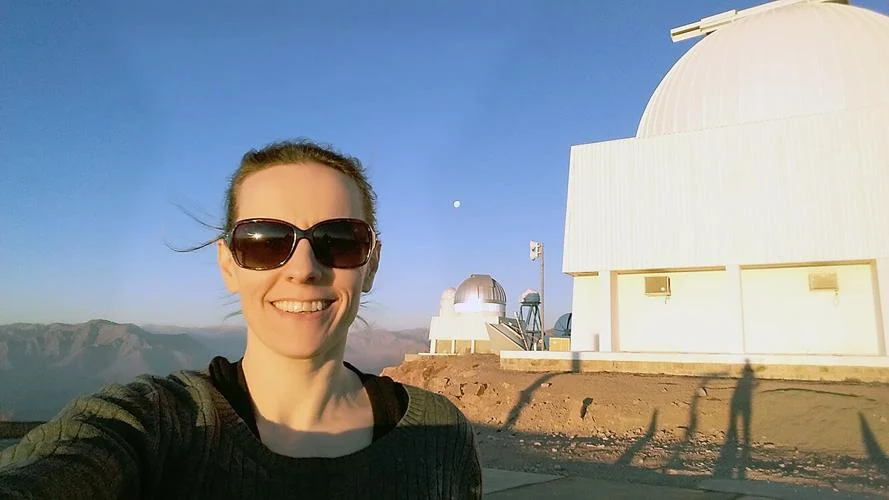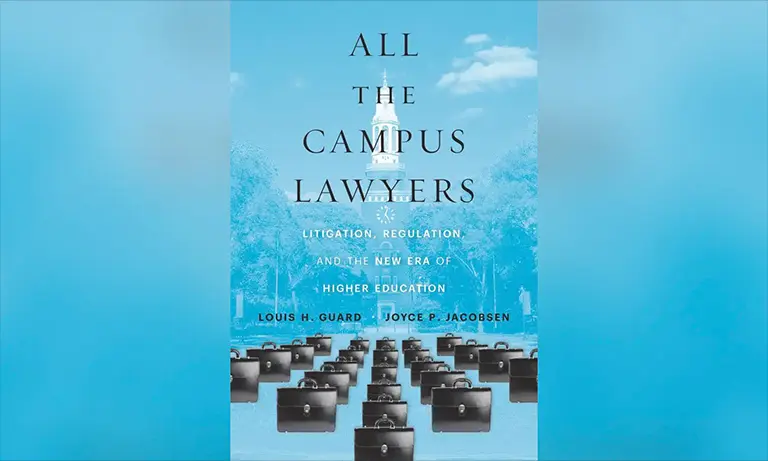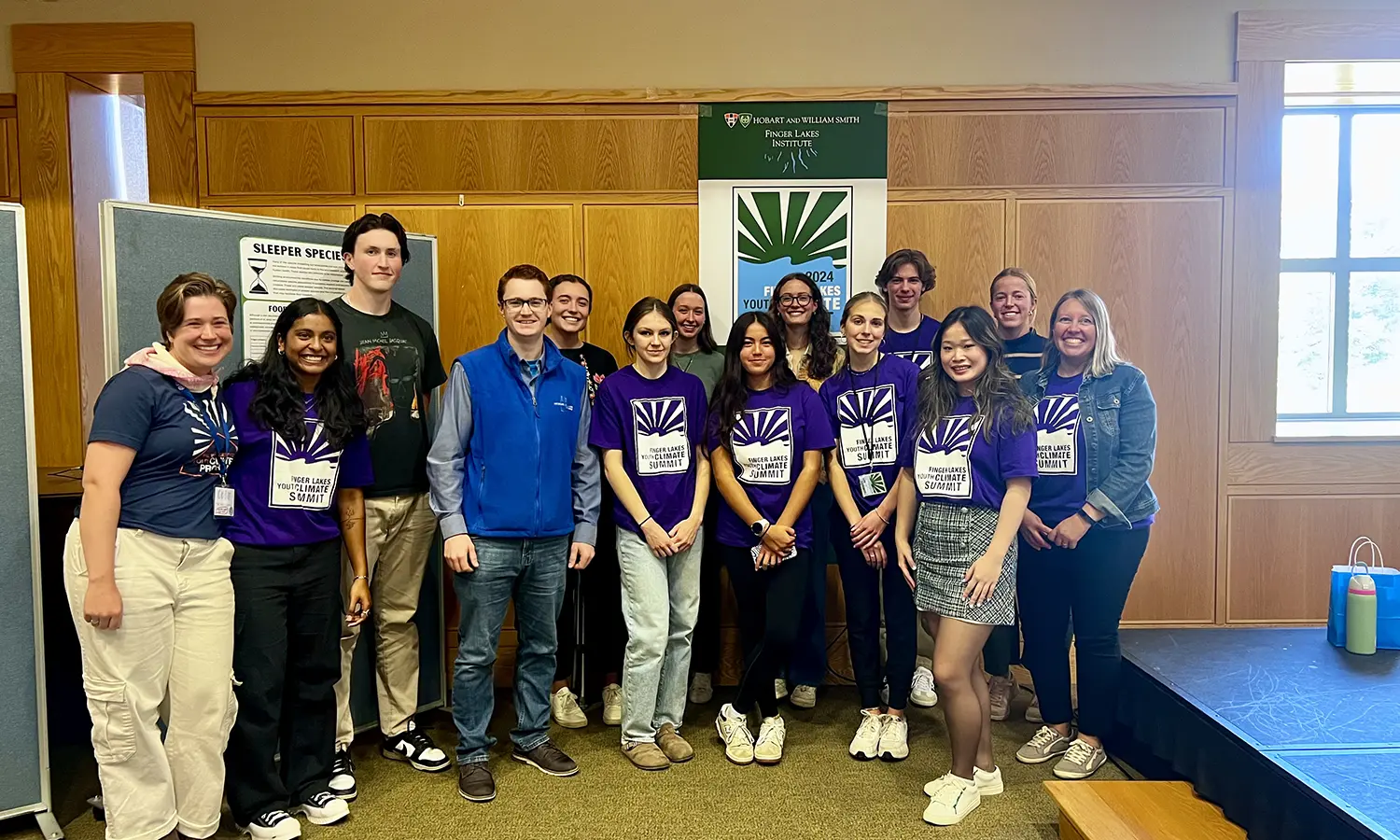
HWS News
25 February 2024 • Faculty • STEM Part of Something Much, Much Bigger Than Ourselves
The Finger Lakes Times interviewed Associate Professor of Physics Leslie Hebb in conjunction with the upcoming total solar eclipse on April 8, 2024.
Feb. 24, 2024 Finger Lakes Times Special Edition
“Part of something much, much bigger than ourselves”
Local teachers, scientists are calling April 8’s total solar eclipse an historic event
By Mike Hibbard
The last time a total solar eclipse was seen in Geneva, Thomas Jefferson was in his second term as President of the United States, future President Andrew Jackson had just killed a man in a duel (the man had accused Jackson’s wife of bigamy), and the Lewis and Clark Expedition that began in 1804 was on its way back to St. Louis after reaching the Pacific Ocean.
“There has not been a total solar eclipse that was visible from Geneva since 1806, although there was one that was very close to us in 1925,” said Leslie Hebb, physics professor at Hobart and William Smith Colleges. “In 1925, a total eclipse was visible from Ithaca but not from Geneva or Rochester. This year it will be visible from Geneva and Rochester, but not Ithaca.”
Hebb and others are encouraging people not to miss the April 8 eclipse in what could be a once-in-a-lifetime opportunity. The next total solar eclipses in New York will be in 2079 (mainly a New York City-area event) and 2144, when parts of the Finger Lakes region will again be a prime viewing area.
“By the time you get to see the next total solar eclipse from your house, your house won’t even be standing. That’s because any given location will see a total solar eclipse once every 360-400 years,” said Dan Naschke, a Geneva High School science teacher who teaches an astronomy elective at the school. “Honestly, your favorite football team has a better chance of winning the Super Bowl than you do of witnessing another solar eclipse like this. I think it is both important and valuable to take advantage of this opportunity. Everyone can learn something from witnessing such a rare and astronomical phenomenon.”
While documented solar eclipses in the United States date to the late 1770s, when the Revolutionary War was still in full swing, it is believed the oldest recorded solar eclipse was on a clay tablet found at Ugarit — in modern Syria — in 1223 BC.
“Our fascination with solar eclipses probably dates back to prehistoric times and even to the earliest periods of human history,” said Tom Carroll, professor emeritus at Keuka College. “The connections between heat and light from the sun and people’s warmth and comfort, the growth of fruits, vegetables, grain ... how life itself is so dependent on the sun — have most likely been accepted for thousands of years. Any sudden blocking of the sun by the moon must have inspired feelings of awe and even fear.”
Tim McConnochie, a research scientist with a doctorate in astronomy from Cornell University, is sharing his expertise with Finger Lakes Community College for an educational experience on the day of the eclipse. A graduate of Pittsford Sutherland High School, he studied the solar corona while he was a student at Williams College in Massachusetts and now works for the Space Science Institute in Rochester.
“I would say that both an eye for beauty and curiosity about the nature of reality are human nature, and total solar eclipses combine those impulses in a unique way,” he said. “Total solar eclipses reveal to the naked eye the solar corona, which is the incredibly hot and incredibly diffuse plasma that is the source of the stellar wind streaming off the sun and filling the solar system with damaging high-energy particles. Those particles damage not just satellites and other spacecraft and astronauts, they also erode the atmospheres of planets while lighting up skies all over the solar system with auroras.”
Hebb, who is leading the HWS “Year of the Sun” series in conjunction with the eclipse, said a total solar eclipse occurs when the moon passes between the Earth and sun, completely blocking the face of the sun.
“Even though the actual size of the moon is tiny compared to the size of the sun (400 times smaller), the moon appears almost exactly the same size in the sky as the sun because it is so much closer (389 times closer),” she said.
Hebb noted that a solar eclipse can only happen during the new moon phase, when the sun and the moon rise together and set together in the sky.
Here is a look at total solar eclipses to affect the continental U.S. since the middle of the 19th century, when astronomy began its modern era of observation: Aug. 7, 1869: The path of totality entered the contiguous U.S. over North Dakota and exited over North Carolina. The path also included Alaska. July 29, 1878: This major eclipse was one of the first to be observed extensively in the U.S. using scientific instruments. Wyoming was the focus of an expedition to record the event. Jan. 1, 1889: The path of this famous “New Year’s Day Eclipse” came ashore just north of San Francisco and passed into Canada from extreme northwest North Dakota. The newly designated Yellowstone National Park was in the path of totality. May 28, 1900: A total eclipse darkened a portion of the Southeast U.S. The Smithsonian Astrophysical Observatory, along with photographer Thomas Smillie, launched a major expedition to observe and photograph this event. The project was dubbed an “exceptional scientific achievement” at the time. June 8, 1918: The most recent great transcontinental total eclipse traversed the U.S. from Washington state to Florida. Totality was observed in Denver. Sept. 10, 1923: The path of totality just barely glanced a small portion of the southern California coastline at Lompoc. Jan. 24, 1925: The path of totality swept across portions of Pennsylvania, Connecticut, and New York State, including New York City, where totality was achieved north of 96th Street in Manhattan. April 28, 1930: This was a “hybrid” eclipse event, meaning it started and finished as an annular eclipse rather than a total eclipse for the entire duration. The path came ashore in northern California and exited the U.S. into Canada via central Montana. Aug. 31, 1932: The path of totality during this event clipped only a small portion of the Northeast, including Vermont, New Hampshire, and southern Maine. July 9, 1945: Only a very small portion of Idaho and Montana saw totality — just at sunrise and for only about an hour — before the eclipse moved into Canada. June 30, 1954: Like the 1945 event, the total eclipse became visible in the U.S. only at sunrise over eastern Nebraska before exiting the U.S. via Wisconsin and Minnesota. The event was a big deal in northern Europe, where the peak of the event occurred in Norway and Sweden. July 20, 1963: Only central Maine saw a total eclipse in the contiguous U.S., although the path of totality bisected Alaska. March 7, 1970: The path of totality came ashore over the Florida panhandle and marched up the Atlantic coast before going offshore over Norfolk, Va. It provided 90% totality to the big East Coast corridor cities from Washington, D.C., to Boston. Charleston, S.C., was in the 100% totality zone. This eclipse may have served as the inspiration for the line “Then you flew your Learjet up to Nova Scotia to see the total eclipse of the sun” in Carly Simon’s pop hit “You’re So Vain,” which was written in 1971 and recorded in 1972 (although Nova Scotia also experienced a total solar eclipse on July 10, 1972). Feb. 26, 1979: The path of this rare wintertime total eclipse coursed across Washington state, northern Idaho, and Montana before entering Canada from extreme northwest North Dakota. A large Pacific storm was affecting the region, and the sun was never clearly visible along the route. Aug. 21, 2017: Dubbed the “Great American Eclipse” by some media, it was visible within a band that spanned the contiguous U.S. from the Pacific to Atlantic coasts — Oregon to South Carolina and touching 14 states. Prior to this event, no solar eclipse had been visible across the entirety of the U.S. since the 1918 event. April, 8, 2024: The path of this coming-very-soon total eclipse will intersect the path of the 2017 event. Being called the “Great North American Eclipse,” it will trace a narrow path of totality across 13 U.S. states, and the Finger Lakes region will be a prime viewing area. Aug. 12, 2045: This total solar eclipse will occur in the U.S., the Caribbean, and South America. In the U.S., the path of totality will cross over California, Nevada, Utah, Colorado, New Mexico, Oklahoma, Kansas, Texas, Arkansas, Missouri, Mississippi, Louisiana, Alabama, Florida, and Georgia. (Primary source: Weather Underground)Total solar eclipse timeline
“Because the moon’s orbit around the Earth is tilted with respect to the Earth’s orbit around the sun, not every new moon will result in an eclipse, but they aren’t uncommon,” she said. “There should be about two solar eclipses every year visible from some location on Earth, but because the relative sizes of the sun and the moon are so closely matched, only a very small region on Earth is directly in the moon’s umbral shadow each time one occurs.
“Seeing a black circle where the sun is supposed to be is something breathtaking, but the experience is not the same if even a little bit of light from the sun is shining through.”
Carroll said the Penn Yan Public Library organized an event for the 2017 partial solar eclipse, when he made a presentation.
“Being a teacher it was my natural inclination to show some slides and diagrams, talk about the science and answer questions. The audience was anxious, however, to start their actual ‘viewing,’ so I quickly changed to a more experiential mode,” he said, noting the library provided laboratory-tested eclipse viewing glasses. “Also, it was a clear, sunny day, and I called folks over to a tree and said, ‘Look down at the sidewalk.’ There they saw many eclipses because most of the leaves had tiny holes. They loved that also.”
Naschke encourages local residents to prepare if they want to be in a prime viewing area.
“There will be a lot of people coming in from surrounding areas to witness this incredible event along with us, so it is important that we plan ahead to make it a smooth and enjoyable experience,” he said. “Make sure you think about where you plan on going to see this eclipse and be sure to leave lots of time for travel as I’m sure roads and streets will be busy and congested. Get your solar eclipse viewing glasses early so you can keep your eyes safe and enjoy this once-in-a-lifetime opportunity.
“On a scientific level, the wonder of an event like the total solar eclipse can provide scientists with opportunities to research some really cool things, but, in general, I think people are drawn to eclipses like this for a number of reasons,” Naschke added. “I feel that witnessing an event like this is amazing, and it reassures us that even though we are a very small part of this universe we are still a part of something much, much bigger than ourselves. Being able to see an eclipse of this significance can bring on an awe inspiring and sometimes overwhelming sense of wonder that makes you feel like a child again.”
Hebb explained that on April 8, the moon will begin to block the sun at 2:07 p.m., initially creating a partial solar eclipse. Over the 75 minutes the moon will progressively block more of the sun, and by 3:21 p.m. the moon will block the entire face of the sun for 2 minutes, 7 seconds.
She added that a free app called Totality (sponsored by the American Astronomical Society) will give anyone details for their location.
Hebb said the sky will darken enough to see a few stars and the solar system planets (like Venus and Jupiter) during the daytime. By 3:24 p.m., the total eclipse will be over in Geneva and the sun will begin to reemerge.
“This is really my opinion, but our modern lives are increasingly individualized with a diminishing number of shared social experiences, especially with large numbers of people,” Hebb said. “Our modern lives give each individual the opportunity to make the decisions that are best for themselves at each moment, which is good, but it means there are fewer and fewer moments in which large numbers of people are doing the same thing at the same time. And this is one of those moments!”
In the photo above, Associate Professor of Physics Leslie Hebb is pictured at an observatory in Chile.



